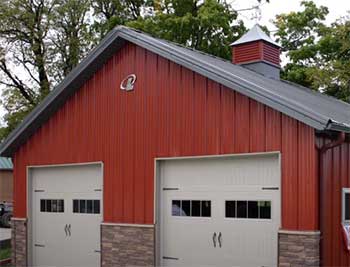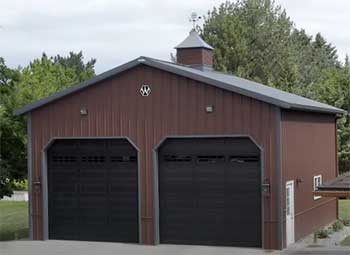When it comes to post-frame buildings, Lester Buildings and Morton Buildings are two of the biggest names in the industry. Both companies have been around for decades and have built thousands of structures across North America.
But when trying to decide between Lester and Morton for your next building project, there are some key differences to consider.
In this comprehensive guide, we’ll compare Lester Buildings vs Morton Buildings to help you determine the right choice for your needs. We’ll look at company history, building components, customization options, warranties, prices and more.
By the end, you’ll understand the pros and cons of each brand and be able to make an informed decision.
A Biref Comparison Table
| Aspects | Lester Buildings | Morton Buildings |
| Company History | Founded in 1955 in Alabama, family-owned | Founded in 1903 in Illinois, family-owned |
| Construction Method | Post-frame buildings | Post-frame buildings |
| Customization | Highly customizable with 50+ color options, trim choices, accessories | Somewhat standardized options, less customization flexibility |
| Warranties | 50-year structure/framework, 40-year steel paint finish | 50-year structure, 25-year steel paint finish |
| Pricing | Very competitive pricing, valued especially for basic buildings | Fair market pricing, upgrades add cost quickly |
| Quality Reputation | Durable buildings that withstand weather, trusted local dealers | High quality materials and fit/finish, A+ BBB rating |
| Delivery Timeframe | 4-6 weeks from order to delivery | 6-8 weeks from order to delivery |
| Best For | Custom projects on a budget, maximum flexibility | Quick turnaround, standardized buildings, smooth process |
Brief Backgrounds on Lester and Morton
First, let’s take a quick look at the origins of each company.

Lester Buildings was founded in 1955 by A.C. Lester in central Alabama.
The company started out constructing small farm buildings and chicken houses.
Today, Lester has dealers in over 30 states and specializes in post-frame buildings for commercial, equestrian, residential and agricultural customers.
Morton Buildings was founded in 1903 by John Mort in Morton, Illinois. After John’s passing, his family kept the company local before his grandson Karl expanded the business nationwide.
Today, Morton focuses primarily on farm, commercial, and personal storage post-frame buildings. They operate in over 40 states.
Both Lester and Morton have long track records in the post-frame building industry. Morton has been around slightly longer, but Lester has made significant expansions over the past few decades.
Key Differences Between Lester Buildings And Morton Buildings
Post-Frame Building Construction
Lester Buildings and Morton Buildings utilize similar post-frame construction techniques. This involves:
- Posts sunk into the ground around the perimeter to provide the structural framing
- Trusses laid across the top of posts to support the roof
- Sidewall girts connected horizontally to the posts to hold up wall sheathing
- Roof sheathing, and sometimes wall sheathing, made from corrugated metal panels
Post-frame is known for quick construction times, economical prices, and versatile designs. It’s ideal for barn-style buildings that don’t require interior load-bearing walls.
Both Lester and Morton offer buildings with clearspan interiors up to 300 feet wide. This allows maximum open floor space without interior columns. For comparison, some pre-engineered metal building suppliers top out at 150 feet clearspan.
Customization Options
One of the biggest differences between Lester vs Morton is the range of custom options available.
Lester Buildings touts their high degree of customizability for each project. They offer:
- 50+ metal color options
- Various trim and accent choices
- Multiple roof and corner styles
- Custom post spacing
- Wide range of accessories like cupolas, vents, windows, insulation and more
This flexibility allows you to personalize the look and functionality of your building. Lester buildings can often mimic the appearance of more expensive traditional barns.
Morton Buildings offers some customization but stays more standardized in their offerings. They focus on simplifying the process for customers. Morton buildings come in standard widths of 36 feet, 42 feet, and 48 feet. You can choose from a few predefined trim/corner/roof options. They offer less metal color and accessory choices compared to Lester.
If customization is important for your vision, Lester will likely be the better choice. Morton simplifies the process with standardized options but less individual flexibility.
Warranties on Materials and Workmanship
The warranties provided by each company offer valuable insight into the quality of materials and construction:

- Lester Buildings provides a 50-year limited warranty on hot-dipped galvanized steel. This covers the steel framework against defects, corrosion, and workmanship. The warranty is transferable if you sell the building.
- For the roof and wall sheeting, Lester provides a 40-year limited paint finish warranty. This covers chalking, cracking, peeling and color change.
- Morton Buildings offers a 50-year limited warranty on the building structure. This covers defects in materials, workmanship, and corrosion resistance. Morton’s warranty can also be transferred to future owners.
- For the exterior Galvalume roof and wall sheeting, Morton provides a 25-year limited warranty on the paint finish. This is 15 years less coverage than Lester’s paint warranty.
The warranties are fairly comparable between the brands. Lester offers slightly longer paint finish coverage, while Morton’s structural warranty encapsulates all materials. Both demonstrate confidence by offering 50+ year warranties that transfer to new owners.
Pricing and Budgets
Pricing is always a major factor when choosing between building suppliers. However, it’s difficult to compare Lester vs Morton prices directly because each project is customized. Here are a few key points:
- Lester Buildings is known for competitive pricing, especially for commercial projects. Their building prices may start 10-15% lower than competitors for simpler designs.
- Morton Buildings pricing is competitive with other post-frame brands. Don’t expect them to be the cheapest option, but rather offer good value for quality.
- Both companies are able to work within budgets. Provide them info on the size, features, and ballpark budget you require.
- Additional customization and accessories will increase costs. Morton’s pricing may rise faster than Lester for upgrades.
- Be sure to get an itemized quote from any building company before committing. This will provide full transparency on pricing.
While both brands can hit most budget targets, Lester may have an advantage for cost-conscious projects needing less frills. Morton pricing is fair but upgrades add up faster.
Quality Reputations
When investing in a new building, you want confidence in its long-term durability and performance. Here are a few indicators of quality for each brand:
- Lester Buildings are known for withstanding tough conditions. Their experience with agricultural buildings ensures durability.
- Many Lester dealers have been providing excellent service in their regions for decades. This demonstrates good local relationships.
- Morton Buildings are recognized for quality materials like 29 gauge steel roofing and sturdy framing. Fit and finish is a strong point.
- Morton has an A+ rating with the Better Business Bureau along with many positive customer reviews. This indicates good service.
Both Lester and Morton have Built up excellent reputations over 50+ years in business. In terms of quality and service, you can feel confident going with either established brand.
Delivery Timeframes
How quickly you need your new building erected is another variable to weigh. Here are typical timeframes:
- Lester Buildings estimates 4-6 weeks from deposit to delivery of materials. Build time ranges from 3 days up to a few weeks depending on size.
- Morton Buildings expects 6-8 weeks from order to delivery for standard models. Build time usually takes 2-3 days for simple designs.
- Timeframes can vary based on region, season, and customization needs. Communicate your timing needs upfront.
- Morton’s standard model process may be faster overall though less customizable. Lester allows more flexibility but adds time.
Lester and Morton buildings both have efficient construction processes refined over decades in business. Morton may be slightly faster while Lester offers more leeway on customization and changes.
Choosing Between Lester vs Morton
To summarize the key differences:
- Lester stands out through high customizability, competitive pricing, and durable construction. They excel at flexibility to meet customer visions.
- Morton shines with standardized quality, faster turnaround, and a smooth order process. Their focus is on simplified buying and building.

For many shoppers, Lester Buildings provide the best value through low costs, flexibility, and robust buildings.
Customization options allow you to dial in the perfect features and looks.
Morton Buildings are ideal if you want quicker turnaround with fewer decisions.
Their standardized models and process enable fast delivery and construction. Less customization also controls pricing.
Both Lester and Morton offer excellent post-frame buildings backed by decades of experience. Identify whether flexibility or simplicity is most vital to your goals. This will point you towards the right brand.
Frequently Asked Questions (FAQ)
Here are answers to some frequently asked questions about Lester and Morton post-frame buildings:
Some of Morton’s biggest competitors in post-frame building construction include: Lester Buildings. Cleary Building Corp., Dansk Barns, Kalmbach Feeds, Smucker Structures, Carolina Barn Builders, Keeton Industries.
As leading national brands, Lester and Cleary are Morton’s closest competitors. The others are strong regional post-frame builders in different parts of the U.S.
For roofing, Morton Buildings uses 29 gauge steel sheeting. This is a sturdy and dent-resistant thickness for roof panels.
For wall sheeting, they offer a choice of 29 gauge or heavier 26 gauge steel. The thicker 26 gauge provides extra durability and protection. Upcharges apply for 26 gauge.
Morton’s standard 29 gauge steel provides robust protection at good value. Adding 26 gauge sheeting enhances longevity even more in vulnerable areas.
Morton Buildings was founded by John Mort in 1903 in Morton, Illinois. After John’s passing, his family continued operations locally for decades.
John’s grandson Karl Mort expanded the company to a national level. He leveraged franchising to open dealerships across the U.S. and grow the business.
Today, Morton Buildings remains family-owned and headquartered in Morton, IL over 100 years after its modest beginnings.
Morton Buildings was originally founded in Morton, Illinois in 1903 by John Mort. The company still maintains their corporate headquarters in this same small town over a century later.
The Morton Buildings name pays homage to the town where John Mort first started constructing barns and buildings with his sons in the early 1900s. As the business grew, Morton embodied the family’s values of integrity, trust, and service.
Final Thoughts
Deciding between trusted brands like Lester and Morton ultimately comes down to your priorities. Key questions to ask:
- How much customization do you need? What design elements are most important?
- What is your budget? How cost-conscious is the project?
- What timeframe do you need for delivery and construction?
- Does exceptional local service reputation matter?
Once you clarify these factors for your specific building goals, you can determine whether Lester or Morton is the better fit. Both companies produce high quality post-frame buildings that stand the test of time.
